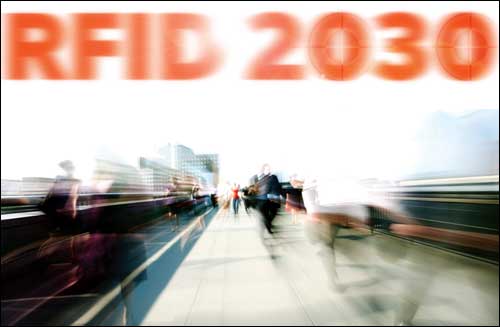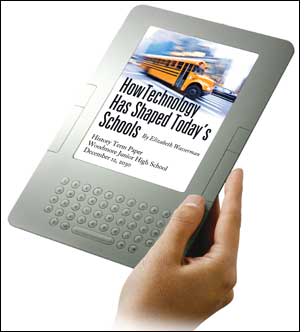Dec 01, 2009All CEOs wish they had a crystal ball, so they could see the future and prepare for it rather than simply react to change. Unfortunately, there's no way to know what the world will be like in, say, 20 years. But we believe radio frequency identification will be widely adopted by 2030 and will have a profound impact not just on the way companies do business, but on the way people shop, travel, learn and more.
Exactly how this growth will take place isn't clear, but there are signs. Technology providers that promote the benefits of RFID and deliver solutions to solve specific business problems, providing a fast return on investment, will lead the way. At the same time, companies that use the technology—to track assets and inventory, streamline operations and business processes, or provide customer services—will create and leverage an RFID infrastructure to achieve even more benefits.
In the scenarios on the following pages, we imagine what the world will be like in 2030. Read them, then ask yourself where your company will be 20 years from today. Will you be powering or using the solutions that attract shoppers to retail stores, expedite product shipments, put the joy back in travel, enhance education, simplify chores and save lives? Or will you be playing catch-up?
* * *
Mr. Wilson's 8th Grade History Term Paper
Woodmore Junior High School
Fairfax, Virginia
December 12, 2030
To examine the role of science or culture in American history, I will contrast school life today with school life 20 years ago. My focus will be on technology—in particular, radio tags—because it encompasses both science and culture.
There is general agreement today that radio tags have helped school districts cut costs, reduce labor, streamline educational and administrative processes, and generally improve education. The technology has been adopted throughout our educational system for everyday tasks—from taking attendance to monitoring science experiments and securing expensive items, including laptops, Segways and electric school buses.
However, two decades ago, before radio tags—originally known as RFID tags—became widely deployed in schools, as well as in business, transportation and government, some people were alarmed by a technology they didn't understand. They were concerned about the cost and privacy implications of RFID. And they worried about change.
According to a 2005 article in the Los Angeles Times, the Brittan Elementary School in Sutter, Calif., started including RFID tags on student ID card holders to reduce the time teachers spent taking attendance at the beginning of each class. But parents were so freaked out—they worried about things like strangers with RFID readers tracking their children outside of school—that the district halted the program. California even passed a law barring the use of RFID in schools. Parents in other towns across the country also fought the use of RFID in schools.
School administrators tried to explain to concerned parents that their children's information was protected—it was encrypted, with restricted biometric access. But it wasn't until 2015, following a rash of kidnappings, including some abductions of students on their way to school, that parents started considering innovative, technology-based ways to protect their kids.
Back then, anxious parents had no way to know if their children had made it safely onto the school bus or to their classrooms—at least not without nagging them to phone or text. Today, of course, all students carry ID badges. Kindergartners and elementary-school students have their badges sewn into backpacks for safekeeping, and most middle- and high-school students—as well as teachers, staff and visitors—keep their badges in a wallet, purse or jeans pocket. School buses know who gets on and off—and when and where. School entryways take attendance as students enter the building. Parents can log on to a school's Web site and access a password-protected account to see what time their kids arrive at school and what time they leave.
Remembering our badges pays off for us students, too. In addition to performing bus-pass and attendance-taking functions, they help us earn reward points for perfect attendance, timely arrival and good behavior. The points are stored on our ID badges, and we can use them for perks—tickets to the latest Suri Cruise movie, an hour in the school's zero-gravity room or video games like Halo 54.
The badges also act as payment cards when students buy lunch in the cafeteria and snacks at the vending machines. They can be programmed to prevent kids from buying foods that contain nuts and other allergens, and to restrict the amount of junk food we eat.
After the Great Recession of 2008-2010, public school districts were suffering from so many budget cuts and tax-revenue shortfalls that President Barack Obama issued the School Bailout Act of 2012. The act made federal government funds available to school districts that decreased their output of greenhouse gases (more on that below) or deployed information technology that resulted in taxpayer savings. That's when school districts started investing heavily in RFID technology.
And it has paid off. By tracking high-value items—such as laptops, sports equipment and musical instruments—schools have reduced loss and theft. Now it even pays for schools to track less expensive items—everything from art supplies to cafeteria trays (the reusable kind, not those wasteful old disposable ones)—which cuts down on overordering of supplies. In addition, most school libraries now use RFID to keep tabs on books, which not only reduces the number and expense of lost and stolen books but also frees up librarians to help students with their research and projects.
These systems offer other benefits, too. Schools can now afford all the cool interactive materials that make learning fun. Many schools that had to cut their music, art and physical education programs have been able to reinstate them. In low-economic districts, schools can provide laptops to students who can't afford them. And in some communities, homeowners have even received a slight reduction in property taxes. (That made some skeptics embrace change!)
Sensors
The School Bailout Act of 2012 also drove RFID adoption because of the desire to cut energy costs and CO2 emissions, which were contributing to global warming. Twenty years ago, school districts had little control over energy expenses. It was virtually impossible to know if classroom lights were left on overnight or thermostats were set too high. The act encouraged school districts to invest in sensor-based networks, which monitor and control lights and temperature from a central location.
Now we even use the school's sensor network in science classes, to monitor the status of chemistry experiments. The sensors automatically record readings of temperature, light or gases emitted at timed intervals during experiments. My parents tell me that when they were in school, they had to sit around with a thermometer and write down the temperature reading of every substance they heated in a beaker.
Temperature sensors also help keep students safe. Twenty years ago, some student athletes became overheated and dehydrated during routine practices and ended up in the hospital—according to news reports, several even died. Now, many schools invest in football helmets that contain built-in heat sensors that alert coaches and trainers on their handhelds if a player's body temperature, hydration level, pulse or other critical factors rise above predetermined thresholds.
History shows us that change doesn't always come easily. But advances in both science and culture—often related to technological innovation—can result in vast improvements in our world and our lives. The integration of RFID technology into America's educational system over the past two decades is a prime example.
Photos and illustrations: iStock Photo. Cover photo: René Mansi/iStock Photo
* * *
We'd like to thank the following people for sharing their insight and expertise to help us look into RFID's future:
• Magda Balazinska, assistant professor, department of computer science and engineering, University of Washington
• Venkat Krishnamurthy, CTO, Checkpoint Systems
• Michael Liard, RFID practice director, ABI Research
• Mike Liebhold, senior researcher, Institute for the Future
• June Ruby, director of manufacturing solutions group, Motorola Enterprise Mobility Solutions
• Alan Sherman, director of marketing, OATSystems
• Chris Warner, senior product manager of RFID, Motorola Enterprise Mobility Solutions
To read more RFID scenarios from the year 2030, click here.




